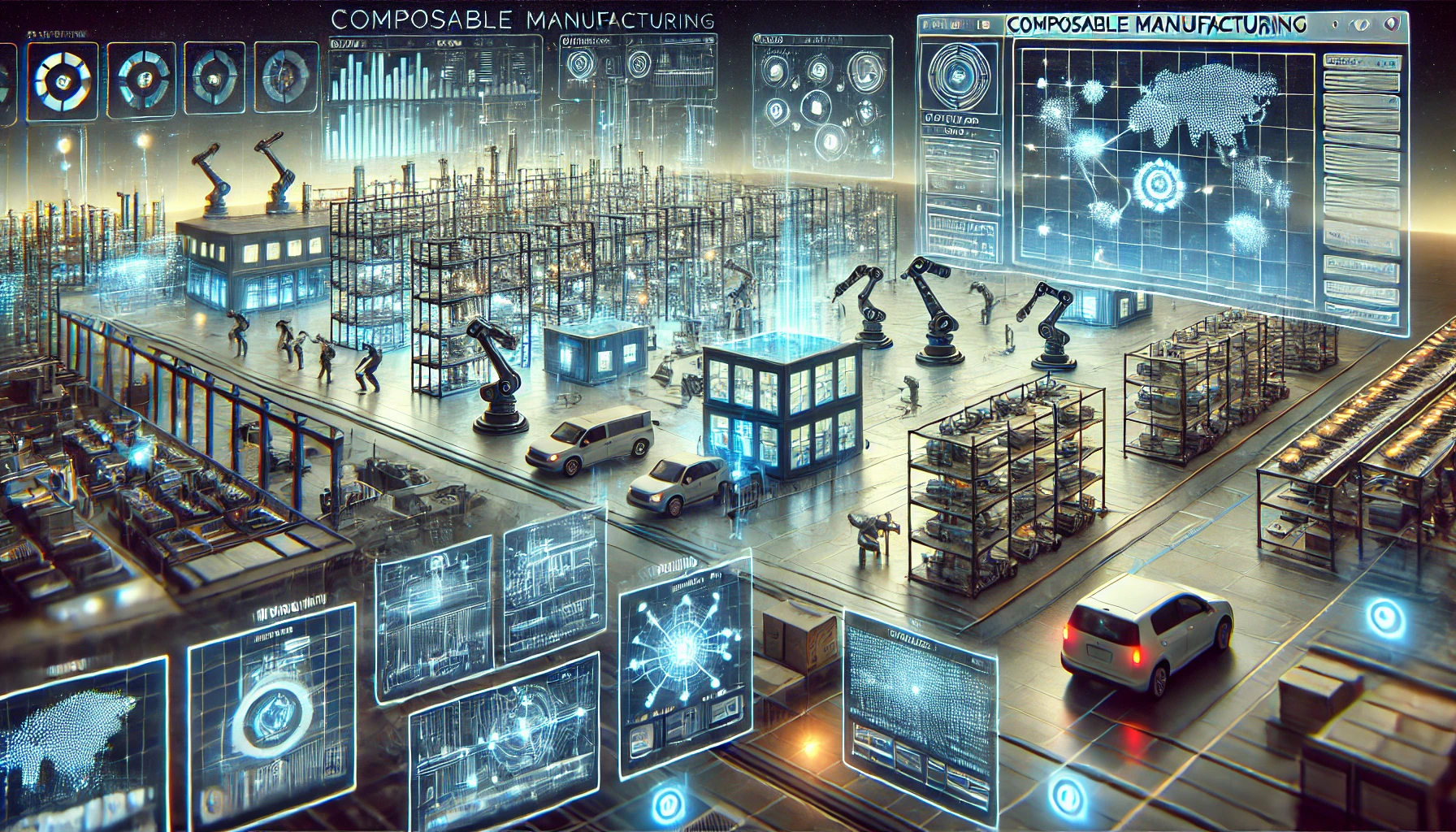Find out how composable manufacturing is changing the game. In a world where flexibility and speed matter most, composable manufacturing is the answer to help manufacturers adapt to changing market demands and optimise their operations. This new way of working is all about modularity and flexibility, so you can add in new technologies and processes to your existing systems. By composable manufacturing you can scale, save and be more competitive in a fast changing world.
Composable Manufacturing
Composable manufacturing is a game changing approach that lets companies create flexible, modular and adaptable production systems. Unlike traditional manufacturing setups which are often rigid and hard to change, composable manufacturing systems are highly configurable. This means manufacturers can respond to changing market demand, optimise production and reduce costs.
At the heart of composable manufacturing are interchangeable components that can be plugged in, unplugged and re arranged. This modularity means manufacturers can scale up or down production seamlessly, accommodate new product designs and reconfigure production lines without downtime or retooling. By using these adaptable systems manufacturers can stay ahead of the curve and be efficient and resilient.
In short composable manufacturing changes how production is managed, a dynamic and responsive approach to the fast pace of today’s markets. It’s more efficient and gives you the agility to meet customer demand and be successful long term.
Understanding Composable Manufacturing Systems

Composable manufacturing systems refer to a new approach to manufacturing that allows for the flexible and modular assembly of production systems. In traditional manufacturing, systems are often built as fixed and rigid structures, making it difficult to adapt to changing production needs. However, composable manufacturing systems are designed to be highly configurable and adaptable, enabling manufacturers to quickly reconfigure their production lines to meet changing market demands. This approach transforms business processes into more dynamic and responsive operations, leveraging digital assets as building blocks for the assembly and reassembly of business processes and application experiences.
These systems consist of various interchangeable components, which can be easily connected, disconnected, and rearranged to create different production configurations. This modularity allows manufacturers to easily scale their production capacity, optimize production processes, and accommodate new product designs without significant downtime or retooling.
By adopting composable manufacturing systems, manufacturers can achieve greater flexibility, agility, and efficiency in their operations, evolving into a composable enterprise. This transformation enables rapid innovation, increased agility, and accelerated digital transformation by creating applications and services that are more modular and adaptable. Low-code platforms can be used to create applications tailored to specific operations, enhancing agility and enabling rapid innovation within a composable enterprise framework. These systems enable them to respond quickly to market changes, reduce production costs, and improve product quality and customization capabilities.
Benefits of Implementing Composable Manufacturing Systems
Implementing composable manufacturing systems delivers business outcomes by offering several benefits for manufacturers. Firstly, these systems provide greater adaptability and scalability, allowing manufacturers to quickly adjust their production lines to meet changing demand and scale up or down as needed. This flexibility helps manufacturers optimize their production capacity and minimize waste, contributing to achieving strategic business goals.
Secondly, composable manufacturing systems enable manufacturers to easily integrate new technologies and processes into their production lines. This allows them to stay up-to-date with the latest advancements in automation, robotics, and data analytics, leading to improved productivity, efficiency, and quality. However, existing systems, such as various ERP solutions and customized legacy systems, can hinder flexibility and scalability. Legacy systems can create complexity in operations and hinder the adaptability needed in modern business architecture, emphasizing the importance of composable operations in streamlining processes and improving system integration. Understanding how benefits from these systems, manufacturers can leverage composable thinking and the adjacent possible theory for incremental improvements and faster achievement of greater outcomes.
Additionally, these systems promote collaboration and interoperability between different components and machines, enabling seamless communication and coordination. This enhances overall operational efficiency and reduces the risk of bottlenecks or disruptions.
Furthermore, composable manufacturing systems support sustainability efforts by reducing energy consumption, minimizing material waste, and optimizing resource utilization. Manufacturers can achieve a more eco-friendly and cost-effective production process.
Overall, implementing composable manufacturing systems empowers manufacturers to stay competitive in a rapidly changing market, enhance operational performance, and achieve long-term growth and success.
Implementation and Best Practices
Implementing composable manufacturing systems requires a strategic approach, careful planning, and ongoing management. Here are some best practices to ensure a successful transition:
-
Assess Your Current Manufacturing Operations: Begin by evaluating your existing production processes, equipment, and systems. Identify areas where composability can bring improvements and pinpoint opportunities for modular integration.
-
Define Your Business Outcomes: Clearly outline the business outcomes you aim to achieve with composable manufacturing. Whether it’s increased efficiency, reduced costs, or enhanced product quality, having well-defined goals will guide your implementation strategy.
-
Allocate Resources: Ensure you have the necessary resources, including budget, personnel, and technology, to support the implementation and ongoing management of composable manufacturing systems. Proper resource allocation is crucial for a smooth transition.
-
Design a Composable Architecture: Develop a composable architecture that allows for the flexible and modular assembly of production systems. Integrate advanced technologies such as artificial intelligence and machine learning to enhance system capabilities and optimize production processes.
-
Implement a Digital Twin: Create a digital twin of your production system to enable real-time monitoring, simulation, and optimization. This virtual replica allows you to test different configurations and scenarios, ensuring optimal performance before making changes to the physical system.
-
Foster a Culture of Continuous Improvement: Encourage a culture of continuous improvement within your organization. Empower employees to identify areas for enhancement and suggest new ideas for increasing composability. This proactive approach will drive ongoing innovation and efficiency.
-
Monitor and Analyze Performance: Regularly monitor and analyze the performance of your composable manufacturing system. Use actionable insights to identify areas for improvement and optimize production processes. Continuous evaluation ensures that the system remains efficient and responsive to changing demands.
By following these best practices, manufacturers can successfully implement composable manufacturing systems and achieve significant business outcomes. This approach not only improves efficiency and reduces costs but also enhances agility, enabling manufacturers to thrive in a rapidly evolving market.
Challenges and Solutions in Composable Manufacturing System Implementation: Seamless Integration
While composable manufacturing systems have many benefits, there are also challenges to overcome during implementation. One of the biggest is the upfront investment required. Manufacturers need to allocate resources to buy the components, retool their production lines and train their workforce on the new system.
Another challenge is the complexity of integrating all the components and making them work together. Manufacturers need to carefully select and design the components so they can talk to each other seamlessly, often requiring an enterprise service bus to make this happen. This may require technical expertise and collaboration with suppliers or experts.
Also, employees may resist or be skeptical of the new composable manufacturing systems. Change management and training programs are key to get employees to understand the benefits of composable manufacturing and adapt to the new way of working. And in-process quality management is critical during this transition so the shift to composable systems doesn’t compromise the manufacturing process.
To overcome these challenges manufacturers can work with system integrators or consultants who specialize in composable manufacturing systems. These experts can guide and support them throughout the implementation process to ensure a smooth transition and get the most out of the new system.
Real-World Applications of Composable Manufacturing Systems
Composable manufacturing systems have found application in various industries, including automotive, electronics, aerospace, and consumer goods. In the automotive industry, these systems enable manufacturers to quickly adapt their production lines to accommodate different vehicle models, reducing time-to-market and improving manufacturing efficiency.
In the electronics industry, composable manufacturing systems allow for the flexible assembly of electronic components, enabling manufacturers to produce a wide range of devices with different specifications. This flexibility supports rapid prototyping, customization, and product diversification.
In the aerospace industry, composable manufacturing systems facilitate the production of complex aircraft components with high precision and efficiency. These systems enable manufacturers to optimize the assembly process, reduce lead times, and enhance overall product quality.
In the consumer goods industry, composable manufacturing systems enable manufacturers to respond quickly to changing consumer demands and market trends. They can easily introduce new product variants, customize products according to individual preferences, and efficiently manage inventory.
These real-world applications demonstrate the versatility and potential of composable manufacturing systems in enhancing productivity, agility, and innovation across different industries. Understanding the manufacturing operations context is crucial for the successful application of composable manufacturing systems across these industries.
Future Market Trends in Composable Manufacturing Systems
The future of composable manufacturing systems is looking bright. One of the big trends is the integration of artificial intelligence (AI) and machine learning (ML) into these systems. AI and ML will enable predictive maintenance, autonomous decision making and optimisation of production processes based on real time data and analytics.
Another trend is the adoption of digital twin technology which creates a virtual copy of the physical manufacturing system. This allows manufacturers to simulate and test different configurations, processes and scenarios before implementing them in the real production environment. Digital twins will improve system design, performance optimisation and predictive analysis.
And the increasing connectivity and interoperability between different manufacturing systems and devices, the Industrial Internet of Things (IIoT) will also play a big part in the evolution of composable manufacturing systems. IIoT enables seamless communication, data sharing and coordination between components, machines and even entire production networks. This will mean better synchronisation, efficiency and responsiveness.
And advancements in additive manufacturing (3D printing) will also enhance composable manufacturing systems. 3D printing will enable on demand production of complex parts and components, reducing inventory storage and rapid prototyping and customisation.
By applying the concept of a composable business architecture this means the framework covers customer engagement, ecosystem partnerships and all operations. It shows how much control businesses have over vendors and the evolution of platforms in different business spaces and how to integrate technology with customer centric strategies.
In summary the future of composable manufacturing systems is automation, intelligence, connectivity and customisation so manufacturers can meet the demands of a fast changing market and achieve new levels of efficiency and innovation.
Role of Manufacturing Operations Management Software in Composable Manufacturing
Manufacturing operations management software, a key component of manufacturing operations software, plays a crucial role in the seamless integration and optimization of composable manufacturing systems. This software acts as the central hub that connects and controls the various components and machines within the production line. It provides real-time monitoring, data analytics, and decision-making capabilities to ensure efficient and effective operation of the system.
One key function of manufacturing operations management software is to manage and schedule production processes based on demand, resource availability, and production goals. It helps manufacturers plan and prioritize tasks, allocate resources effectively, and optimize production workflows to maximize productivity and minimize downtime. Manufacturing operations software vendors are pivotal in evolving these systems towards a composable business architecture, offering solutions that enable businesses to assemble and reassemble different business elements seamlessly.
Additionally, this software enables manufacturers to track and analyze key performance indicators (KPIs) such as production output, quality metrics, and equipment efficiency. By collecting and analyzing data from different components and machines, manufacturers can identify bottlenecks, inefficiencies, and areas for improvement in the production process.
Moreover, manufacturing operations management software facilitates communication and collaboration between different stakeholders involved in the manufacturing process. It enables seamless information sharing, task assignment, and workflow coordination to ensure smooth operation and timely completion of production tasks.
Furthermore, this software can support predictive maintenance by monitoring equipment performance, detecting anomalies, and recommending maintenance actions to prevent breakdowns and disruptions. By implementing predictive maintenance strategies, manufacturers can reduce downtime, extend equipment lifespan, and improve overall equipment effectiveness.
Overall, manufacturing operations management software acts as a critical enabler for composable manufacturing systems, providing the necessary tools and capabilities to optimize production processes, enhance efficiency, and drive continuous improvement in manufacturing operations.
Share this
You May Also Like
These Related Stories

Manufacturing Operations Technology is Changing the Modern Factory

Scaling Production Processes for Small Business Manufacturers


No Comments Yet
Let us know what you think